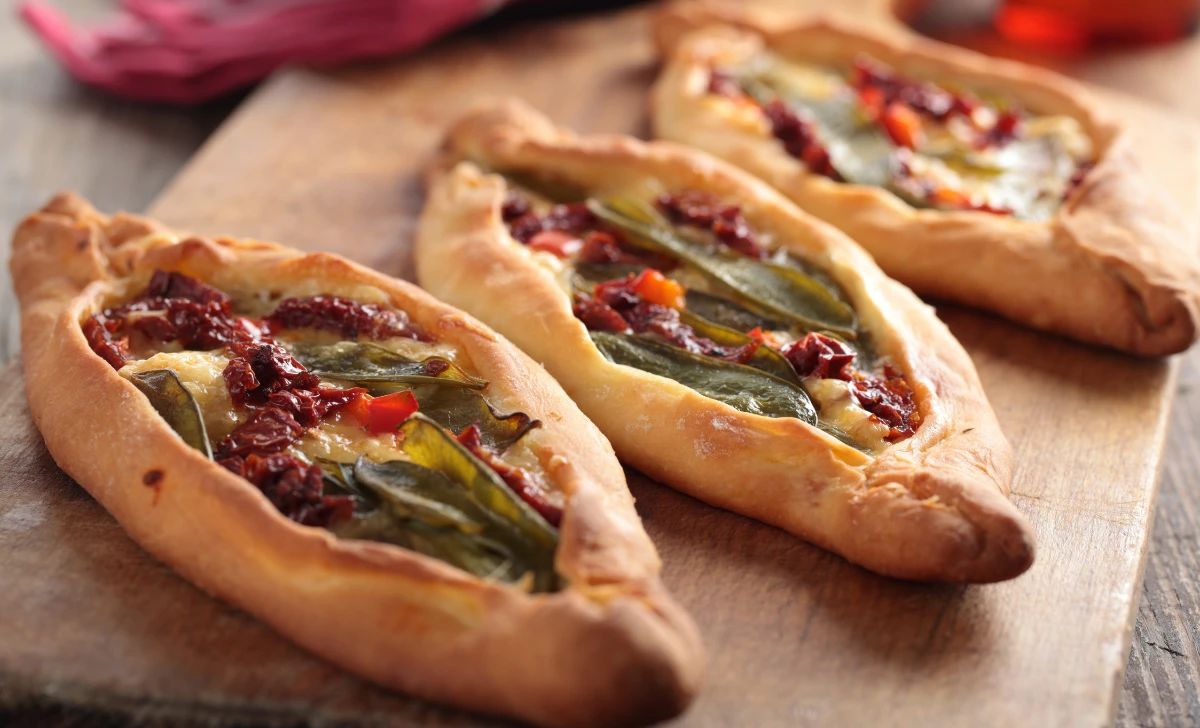If you’re a fan of Mediterranean cuisine, you’re in for a treat with the mouthwatering Pide. Pide is a traditional Turkish flatbread that can be likened to a pizza, but with a unique twist. With its fluffy crust and delectable toppings, Pide is a favorite dish enjoyed by locals and visitors alike. In this article, we will explore the art of making Pide from scratch, with step-by-step instructions and helpful tips to ensure your Pide turns out perfect every time.
[ez-toc]
History
The roots of Pide can be traced back to ancient Anatolia, a region that now comprises modern-day Turkey. The name “Pide” is believed to have originated from the Persian word “pīdā,” meaning “to stretch.” This hints at the dough-stretching process involved in making this delicious flatbread.
The history of Pide dates back thousands of years, and its evolution has been influenced by various cultures that settled in the region throughout history. It is said that the early versions of Pide were simple unleavened bread, prepared by nomadic tribes who roamed the Anatolian plains. These tribes would cook the bread on the hot stones of their campfires, creating a basic, filling food that sustained them during their journeys.
As civilization flourished in Anatolia, so did the art of bread-making. Leavened bread, introduced to the region by the ancient Egyptians, found its way into Turkish cuisine. This advancement marked a turning point in Pide’s history, transforming it from a basic flatbread to a more sophisticated culinary delight.
Over the centuries, Pide continued to evolve, with each region in Turkey adding its own unique touch to the recipe. Local ingredients and culinary traditions influenced the toppings used on Pide, making it a diverse and flavorful dish. As trade routes opened, the popularity of Pide spread beyond Turkey’s borders, gaining admirers in neighboring countries and faraway lands.
Fast forward to the present day, Pide has become an essential part of Turkish culinary culture, served in restaurants, cafes, and homes across the country. Its global recognition as a delectable and savory dish has earned it a place in the hearts and stomachs of food enthusiasts worldwide.
In recent times, Pide has also embraced modern twists, with chefs experimenting with a wide range of ingredients and fillings. From traditional toppings like cheese, minced meat, and vegetables to innovative combinations that cater to various tastes, Pide has continued to evolve while retaining its rich history and cultural significance.
The Timeless Appeal of Pide
As Pide continues to tantalize taste buds and bring people together over a shared love for good food, its journey through time and taste remains a testament to the enduring power of culinary traditions. So, the next time you savor a warm, fragrant slice of Pide, remember that you’re indulging in a dish that carries with it the history, flavors, and soul of a fascinating culinary heritage.
Time
| Step | Time (approx.) |
|---|---|
| Making the Dough | 1 hour |
| Allowing the Dough to Rest | 30 minutes |
| Preparing the Toppings | 20 minutes |
| Preheating the Oven | 10 minutes |
| Rolling out the Dough | 15 minutes |
| Assembling and Topping the Pide | 10 minutes |
| Baking the Pide | 15-20 minutes |
| Total | 2 hours 25 minutes |
Please note that the times provided are approximate and may vary depending on individual cooking methods and experience. It’s essential to allow the dough to rest adequately for optimal results.
Ingredients
| Ingredients | Quantity |
|---|---|
| All-purpose flour | 2 cups |
| Active dry yeast | 1 teaspoon |
| Warm water | ¾ cup |
| Olive oil | 2 tablespoons |
| Salt | 1 teaspoon |
| Ground lamb or beef | ½ pound |
| Onion, finely chopped | 1 small |
| Tomato, diced | 1 small |
| Bell pepper, diced | ½ small |
| Turkish or mozzarella cheese | 1 cup |
| Black olives, sliced | ¼ cup |
| Fresh parsley, chopped | 2 tablespoons |
| Ground black pepper | To taste |
These quantities are approximate and can be adjusted according to personal preference. Make sure to have all the ingredients ready before starting the Pide-making process.
Directions
1. Making the Dough
Ingredients:
- All-purpose flour
- Active dry yeast
- Warm water
- Olive oil
- Salt
- In a large mixing bowl, combine the all-purpose flour and salt.
- In a separate small bowl, dissolve the active dry yeast in warm water and let it sit for 5 minutes until frothy.
- Pour the yeast mixture into the flour mixture and add olive oil.
- Mix well until a dough starts to form.
- Transfer the dough onto a lightly floured surface and knead for about 10 minutes until it becomes smooth and elastic.
- Shape the dough into a ball and place it in a greased bowl. Cover it with a clean kitchen towel and let it rest in a warm area for about 1 hour or until it doubles in size.
2. Preparing the Toppings
Ingredients:
- Ground lamb or beef
- Onion, finely chopped
- Tomato, diced
- Bell pepper, diced
- Turkish or mozzarella cheese
- Black olives, sliced
- Fresh parsley, chopped
- Ground black pepper
- In a skillet, cook the ground lamb or beef over medium heat until browned. Drain any excess fat.
- Add the finely chopped onion to the skillet and cook until translucent.
- Stir in the diced tomato and bell pepper, cooking for an additional 2-3 minutes until the vegetables are slightly softened.
- Season the mixture with ground black pepper and salt to taste. Set aside to cool.
3. Assembling and Baking the Pide
Ingredients:
- Prepared dough
- Prepared toppings
- Preheat the oven to 475°F (245°C) and place a baking stone or baking sheet in the oven to heat.
- Punch down the dough and divide it into two equal portions.
- On a floured surface, roll out each portion into an oval or rectangular shape, about ¼ inch thick.
- Transfer the rolled-out dough onto a piece of parchment paper.
- Spread half of the prepared toppings evenly on each dough, leaving a small border around the edges.
- Sprinkle the Turkish or mozzarella cheese, black olives, and fresh parsley on top of the toppings.
- Carefully transfer the parchment paper with the assembled Pides onto the preheated baking stone or baking sheet.
- Bake for 15-20 minutes or until the crust turns golden brown and the cheese is melted and bubbly.
- Remove from the oven and let it cool for a few minutes.
- Slice the Pide into portions and serve warm.
Equipment Required
Nutrition Information
| Nutrient | Amount Per Serving |
|---|---|
| Serving Size | 1 Pide (Half) |
| Calories | 400 |
| Total Fat | 15g |
| – Saturated Fat | 6g |
| – Trans Fat | 0g |
| Cholesterol | 45mg |
| Sodium | 600mg |
| Total Carbohydrate | 50g |
| – Dietary Fiber | 3g |
| – Sugars | 3g |
| Protein | 20g |
| Vitamin D | 0mcg |
| Calcium | 200mg |
| Iron | 4mg |
| Potassium | 300mg |
Please note that the provided nutrition information is an estimate and may vary depending on the specific ingredients and quantities used. It’s always a good idea to refer to the packaging or consult a nutritionist for precise and personalized information based on your recipe and ingredients.
Tips
- Proofing the dough: Make sure to let the dough rise in a warm area free from drafts to allow proper fermentation and rise.
- Toppings customization: Feel free to customize the toppings based on your preferences. You can add sliced mushrooms, crumbled feta cheese, sliced sujuk (Turkish sausage), or even roasted vegetables for a unique twist.
- Texture enhancement: For a softer and fluffier dough, you can substitute a portion of the all-purpose flour with bread flour. This will give your Pide a chewier texture.
- Preheating the baking stone or sheet: Preheating the baking stone or sheet before placing the Pide on it helps achieve a crispy bottom crust.
- Pide shapes: While the traditional shape of Pide is oval or rectangular, don’t be afraid to experiment with different shapes like round or even individual-sized mini Pides.
- Using a pizza stone: If you have a pizza stone, it can be an excellent alternative to a baking sheet. Just make sure to preheat it adequately to achieve a crispy crust.
- Serving suggestions: Pide is delicious on its own, but you can elevate the meal by serving it with a side of tangy yogurt sauce, a fresh salad, or pickles for added flavor contrast.
- Make-ahead option: If you want to save time, you can prepare the dough in advance and refrigerate it overnight. This allows for easier planning and a quicker assembly when you’re ready to bake.
- Vegetarian option: For a vegetarian version, you can replace the meat with a combination of sautéed vegetables like zucchini, eggplant, and bell peppers. Add crumbled tofu or plant-based protein for added substance.
- Experiment with herbs and spices: Add extra flavor to your Pide by incorporating herbs like oregano, thyme, or basil, and spices such as cumin or paprika into the toppings.
Pros & Cons
| Pros | Cons |
|---|---|
| ✅ Delicious and flavorful | ❌ Requires time for dough preparation |
| ✅ Versatile toppings and variations | ❌ High calorie and fat content |
| ✅ Can be customized to dietary needs | ❌ May be challenging for beginners |
| ✅ Great for sharing with family | ❌ Requires access to an oven |
| ✅ Reflects a rich culinary heritage | ❌ Can be messy to assemble and eat |
Conclusion
In conclusion, Pide is a delectable Turkish delight that combines the best of flatbread and pizza, resulting in a truly mouthwatering experience. With its fluffy crust, customizable toppings, and rich flavors, Pide offers a delightful culinary adventure for your taste buds.
This recipe has taken you on a journey through the history, preparation, and variations of Pide. From the ancient roots of Anatolia to the modern-day kitchens, Pide has stood the test of time, captivating food enthusiasts across the globe.
By following the step-by-step instructions provided, you can create your own Pide masterpiece right in the comfort of your kitchen. The process of making the dough, preparing the toppings, and assembling the Pide is not only a chance to explore the art of Turkish cuisine but also an opportunity to put your own creative touch on this traditional dish.
Whether you’re sharing a meal with loved ones, hosting a gathering, or simply treating yourself to a flavorsome delight, Pide is a versatile and satisfying choice. Its unique flavors, coupled with the joy of making it from scratch, will surely leave a lasting impression.
So, why not embark on a culinary adventure and try your hand at making Pide? Gather the ingredients, roll up your sleeves, and embrace the aroma and taste of this Turkish treasure. You’ll be rewarded with a memorable dining experience and the satisfaction of creating a homemade dish that celebrates tradition and flavor.
Don’t hesitate—unleash your inner chef, and let Pide transport you to the vibrant and diverse world of Turkish cuisine. It’s time to savor every bite and enjoy the culinary masterpiece that is Pide.
Facts
- 1. 🌍 A Culinary World Traveler
- Did you know that Pide has traveled beyond Turkey’s borders? This delicious dish has gained popularity internationally, with variations and adaptations found in countries like Greece, Bulgaria, Armenia, and even as far as Azerbaijan. Pide’s flavorsome journey continues to captivate taste buds worldwide.
- 2. 🍕 Pide vs. Pizza: The Tasty Rivalry
- While Pide and pizza share some similarities, they have distinct characteristics that set them apart. Pide’s dough is typically thicker, fluffier, and enriched with olive oil, giving it a unique texture. Its toppings often include a delightful mix of local ingredients, herbs, and spices that differentiate it from the classic pizza we know and love.
- 3. 🏺 A Heritage Dating Back Millennia
- Pide’s roots can be traced back thousands of years to ancient civilizations that once flourished in Anatolia. This region, rich in history, culture, and culinary traditions, has influenced the evolution of Pide into the beloved dish it is today. Enjoying Pide is like savoring a piece of living history with every bite.
- 4. 🥢 Pide: From Streets to Tables
- In Turkey, Pide has a long-standing tradition of being prepared and sold by street vendors known as “pideciler.” These skilled artisans handcraft Pide in large, open ovens, filling the streets with irresistible aromas. While enjoying Pide in restaurants and homes is common today, the spirit of street food culture remains an integral part of its charm.
- 5. 🍽️ The Joy of Sharing
- One of the beautiful aspects of Pide is its ability to bring people together. Whether it’s a family gathering, a casual dinner with friends, or a festive celebration, Pide is often enjoyed as a shared meal. The joy of breaking off a piece, dipping it in tangy yogurt, and sharing the flavorsome experience creates lasting memories and strengthens bonds.
FAQ’s
Can I use instant yeast instead of active dry yeast?
Yes, you can substitute instant yeast for active dry yeast. Use the same amount, but you can skip the step of proofing the yeast in warm water. Simply add it directly to the flour.
Can I make Pide gluten-free?
Yes, you can try using gluten-free all-purpose flour or a gluten-free bread flour blend as a substitute for regular flour. Adjustments may be needed in terms of liquid and baking time, so it’s advisable to follow a gluten-free recipe specifically designed for Pide.
Can I make the dough ahead of time and refrigerate it?
Yes, you can prepare the dough in advance, allowing it to rise and then refrigerating it for up to 24 hours. When ready to use, let it come to room temperature before rolling it out and proceeding with the recipe.
Can I freeze the unbaked Pide for later use?
Yes, you can freeze unbaked Pide. After assembling the Pide, wrap it tightly in plastic wrap or place it in an airtight container. When ready to bake, allow it to thaw in the refrigerator overnight, then proceed with baking as instructed.
Can I reheat leftover Pide?
Absolutely! Preheat your oven to around 350°F (175°C), place the leftover Pide slices on a baking sheet, and warm them for about 10 minutes or until heated through. This will help restore the crispness of the crust and melt the cheese.
What can I serve with Pide?
Pide is delicious on its own, but you can complement it with a side of tangy yogurt sauce, a fresh salad, or pickles for added flavor and variety.
Can I make mini Pides instead of a larger one?
Yes, you can make individual-sized mini Pides by dividing the dough into smaller portions and adjusting the baking time accordingly. This is a fun option for parties or gatherings.
How long does the baked Pide stay fresh?
Baked Pide is best enjoyed fresh on the day it is made. However, if properly stored in an airtight container or wrapped in foil, it can stay fresh for up to 2 days at room temperature. Reheat it in the oven before serving.
Can I use pre-made pizza dough for Pide?
While pre-made pizza dough can be used as a time-saving option, keep in mind that the texture and flavor may differ slightly from traditional Pide dough. Experiment and adjust baking times accordingly.
Can I make Pide without an oven?
The traditional method of baking Pide involves an oven. However, if you don’t have access to an oven, you can try cooking the assembled Pide on a stovetop using a skillet or griddle. Cook it covered on low heat until the crust is golden and the cheese has melted.












Leave a Review